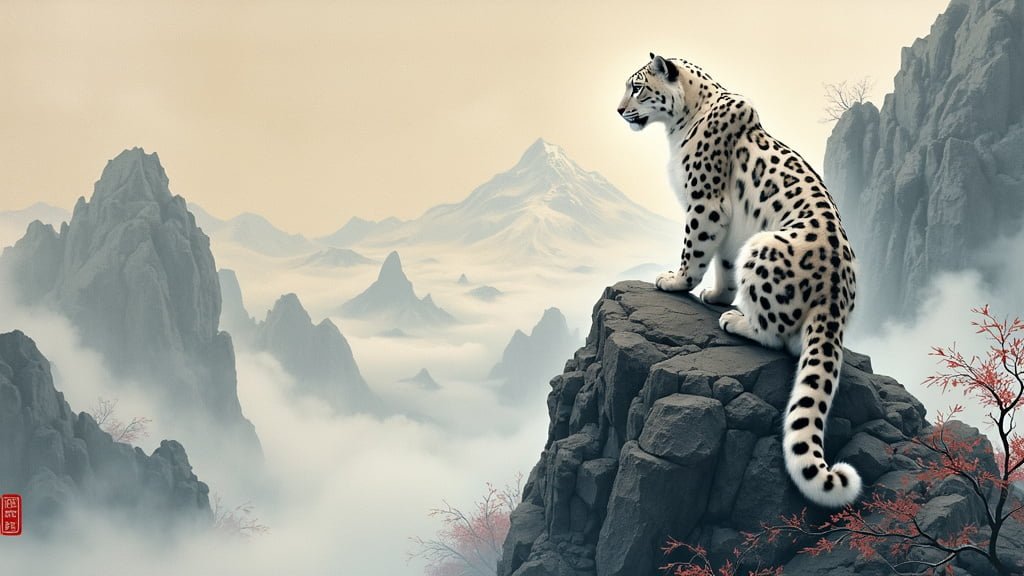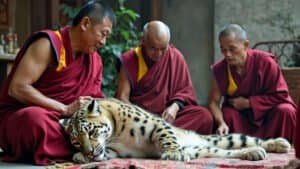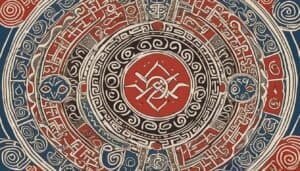Introduction
Snow leopards hold a revered place in Chinese culture, symbolizing strength, agility, and mysticism throughout history. From ancient myths and legends to art and poetry, snow leopards have played a significant role in shaping Chinese cultural heritage
This article will explore the spiritual significance of snow leopards in mythology, their intricate depictions in art, and how they have been represented in Chinese literature over centuries
By examining these various aspects, we can gain deeper insight into the ways snow leopards have influenced Chinese history and modern cultural narratives
Snow Leopards in Chinese Mythology and Folklore
Snow leopards have been woven into the fabric of Chinese mythology and folklore for centuries. They are often depicted as symbols of power, grace, and mysticism, much like the dragons and tigers of Chinese mythology
The elusive nature of snow leopards, their habitat in remote mountainous regions, and their association with the cold, rugged environment of the Tibetan Plateau and other highlands have further deepened their mythical status in China. Revered for their strength and agility, snow leopards were believed to possess spiritual qualities, serving as guardians of the mountains and representing the balance between ferocity and serenity
In many traditional stories, snow leopards act as protectors of sacred places or as embodiments of natural forces. Their symbolism reflects the deep respect ancient Chinese cultures had for the natural world, particularly the wilderness of China’s vast mountainous regions
Key Myths Featuring Snow Leopards
In Chinese mythology, snow leopards appear in various stories and legends, often serving as intermediaries between humans and the natural or spiritual worlds
One notable myth from the Tibetan regions of China tells of the snow leopard as a guardian spirit, protecting villagers from evil forces and natural disasters. In these stories, the snow leopard is sometimes depicted as a shapeshifter, capable of transforming into a human form to communicate with people
Other folktales present the snow leopard as a wise creature, advising rulers or spiritual leaders on matters of governance and balance in nature. These narratives highlight the respect given to snow leopards as creatures of both physical power and spiritual significance
Another significant belief ties snow leopards to the concept of yin and yang, a fundamental principle in Chinese philosophy representing the balance of opposites
Snow leopards, with their ability to thrive in harsh, barren environments, were seen as a perfect embodiment of this balance—combining strength with solitude, aggression with calm. As creatures that live in remote, inaccessible areas, they also symbolized the mystical and unseen forces of nature, adding to their mythical allure
Role of Snow Leopards in Folktales
In local folktales from the Qinghai and Tibetan regions, snow leopards are often associated with spiritual powers. In these narratives, they protect sacred spaces, mountain shrines, or temples from intrusion
Some stories tell of snow leopards leading travelers safely through treacherous mountain passes, serving as divine guides in times of peril. This protective role further cements their place as revered animals in local belief systems
In contrast, some legends also speak of snow leopards as challenges or adversaries for those who stray too far from the path of righteousness, testing the strength and virtue of heroes. In either case, snow leopards are portrayed as majestic and otherworldly beings with a deep connection to the natural and spiritual worlds
Symbolism of Snow Leopards in Chinese Beliefs
The symbolism of snow leopards in Chinese culture is multifaceted. Their presence in the high mountains ties them to notions of purity, detachment from the mundane world, and spiritual ascension
In many traditional Chinese belief systems, mountains are sacred spaces where heaven and earth meet, and the creatures that inhabit them are often seen as closer to divine forces. Snow leopards, inhabiting the highest and most remote ranges, were thus thought to possess a spiritual power unmatched by other animals
Moreover, their stealth and elusive nature contributed to their symbolic representation as mysterious, almost supernatural creatures. The snow leopard’s silent hunting methods were admired as a reflection of patience, precision, and discipline—qualities valued in Chinese martial traditions and philosophies like Taoism
Their pale, camouflaged appearance also linked them to the element of water, and by extension, to adaptability and fluidity in Chinese cosmology. These attributes made the snow leopard a powerful symbol in rituals and prayers for protection, guidance, and harmony with the natural world
Artistic Depictions of Snow Leopards in Chinese History
Throughout Chinese history, snow leopards have been featured in various forms of traditional art, including paintings, sculptures, and textiles. These depictions not only celebrate the beauty and power of the animal but also reflect the cultural and spiritual meanings attributed to snow leopards
The combination of their majestic presence and their connection to remote, sacred landscapes made snow leopards a compelling subject for artists, particularly during times when nature and wildlife played a key role in Chinese artistic expression
Their portrayal evolved over time, reflecting the changing perspectives of both the natural world and the symbolic roles animals played in society
Snow Leopards in Traditional Paintings
Snow leopards first appeared in Chinese painting during the Tang Dynasty (618–907 AD), when landscape art began to flourish as a significant genre. In classical Chinese paintings, snow leopards are often depicted roaming rocky, snow-covered mountain ranges, blending seamlessly into their environment
This artistic choice highlighted the snow leopard’s elusive nature and its connection to rugged, almost otherworldly landscapes. These paintings frequently used traditional ink and watercolor techniques, allowing the artist to emphasize the delicate balance between the snow leopard’s graceful form and the starkness of its environment
During the Song Dynasty (960–1279 AD), a period known for its emphasis on naturalistic detail and subtlety in animal depictions, artists painted snow leopards with great precision. The animals were often placed in the context of vast, serene landscapes, with their soft fur and powerful stance rendered in fine brushstrokes
This attention to detail symbolized the harmony between the creature and the natural world, a key theme in Chinese landscape painting. One famous example is the work of Ma Yuan, whose depictions of animals like the snow leopard often conveyed a sense of tranquility and reverence for nature’s beauty
Representations in Sculpture and Embroidery
In addition to paintings, snow leopards appeared in sculptures and embroidery, particularly during the Ming (1368–1644) and Qing (1644–1912) Dynasties. Stone and jade carvings of snow leopards were commonly used to decorate temples and sacred sites in the mountainous regions of China
These sculptures were not merely decorative; they were believed to serve a protective function, warding off evil spirits and ensuring the safety of the surrounding area. Their powerful forms, often depicted mid-stride or in a resting pose, conveyed strength and vigilance, qualities that resonated with the spiritual beliefs tied to snow leopards as guardians of the mountains
Embroidery, especially on garments worn by nobility and spiritual leaders, often featured intricate snow leopard designs. These motifs were highly valued for their association with power, resilience, and spiritual guardianship
In Tibetan-influenced areas of China, robes and tapestries adorned with snow leopard patterns symbolized a deep connection to the wild and spiritual realms, reflecting the sacred status of the animal in both art and religious practice
The Evolution of Snow Leopard Imagery Over Time
The representation of snow leopards in Chinese art has evolved from traditional spiritual symbolism to more modern depictions emphasizing conservation and ecological awareness. In early Chinese art, the snow leopard’s role was largely symbolic, representing mystical power and protection in a spiritual context
However, during the 20th century, with the rise of nature conservation movements and awareness of endangered species, the snow leopard began to appear in artwork and propaganda aimed at raising awareness about wildlife preservation
In contemporary Chinese art, snow leopards are often portrayed as endangered species whose survival is tied to the preservation of their natural habitat. Modern painters, photographers, and sculptors have drawn attention to the vulnerability of the snow leopard population, reflecting a shift in focus from mythological symbolism to ecological reality
These artworks often highlight the snow leopard’s struggle against habitat loss and poaching, encouraging a deeper connection between the public and wildlife conservation efforts
Spiritual and Ecological Meanings of Snow Leopards
In Chinese culture, snow leopards hold significant spiritual meanings that tie into broader ecological beliefs. Revered as protectors of nature and as creatures with mystical qualities, they are often associated with purity, solitude, and balance
These qualities reflect not only the physical characteristics of the snow leopard but also the Chinese cultural view of mountains and wildlife as spaces imbued with spiritual importance
Snow leopards, living in some of the most remote and harsh environments in China, embody traits that align with traditional spiritual beliefs, while their presence also underscores modern ecological perspectives that emphasize the importance of environmental stewardship
Snow Leopards as Spiritual Protectors
In regions like Tibet and Qinghai, where snow leopards are more commonly found, they are often regarded as sacred creatures with protective powers. Local beliefs view these animals as guardians of mountain temples and sacred sites, preventing the desecration of holy places
The rugged mountains that snow leopards inhabit are traditionally seen as realms closer to the heavens, and the animals living there are considered messengers or intermediaries between the human and divine worlds. As a result, snow leopards are often believed to offer spiritual protection not only to the natural world but also to those who live in or traverse these high-altitude environments
In Tibetan Buddhism, snow leopards are sometimes connected with the teachings of compassion and nonviolence, reflecting the values that guide interactions with nature
These beliefs suggest that snow leopards, despite their powerful predatory instincts, are beings that live in harmony with the earth, taking only what they need and existing as part of the natural order. This view reinforces the idea of balance, a central theme in many Asian spiritual traditions, where every element of nature has a role and purpose
Environmental Symbolism in Chinese Culture
The snow leopard’s existence in remote and often untouched areas of China makes it a potent symbol of nature’s purity and resilience
In Chinese cosmology, animals that inhabit the highest reaches of mountains are considered embodiments of natural forces, tied to elements like wind, water, and stone. Snow leopards, with their pale fur and solitary habits, are often associated with the element of water, symbolizing fluidity, adaptability, and strength in challenging environments
This connection aligns with Taoist philosophies that emphasize harmony with the natural world, where the snow leopard becomes a metaphor for adapting to life’s harshest conditions with grace and perseverance
Moreover, the snow leopard’s elusive and solitary nature reflects broader Chinese views on self-reliance and spiritual clarity. In ancient China, mountains were often considered places of retreat for monks, scholars, and those seeking spiritual enlightenment
Snow leopards, dwelling in these same regions, came to symbolize the virtues of isolation and self-discovery, representing the idea that true wisdom comes from a deep connection with nature, away from the distractions of everyday life
Regional Beliefs About Snow Leopards in China
In addition to their spiritual significance, snow leopards have played a role in regional beliefs about the environment and human interactions with nature. In Qinghai, Tibet, and parts of Xinjiang, local legends describe snow leopards as protectors of the land, ensuring that the natural balance is maintained
These beliefs often highlight the importance of coexisting with wildlife rather than dominating it, suggesting that humans must respect the territories and needs of creatures like snow leopards to avoid misfortune or environmental degradation
These regional beliefs also tie into practical ecological concerns. Snow leopards are considered indicators of environmental health because they occupy the top of the food chain in their ecosystems. Their presence signifies a balanced and thriving environment, whereas their decline often points to broader ecological issues, such as habitat loss or the depletion of prey species
Thus, the spiritual reverence for snow leopards is closely linked with modern ecological awareness, blending ancient beliefs with contemporary concerns about conservation and biodiversity
In modern China, efforts to protect snow leopards have been framed not only as ecological necessities but also as culturally significant actions. By preserving the snow leopard and its habitat, China is also preserving the spiritual heritage tied to these majestic animals
This holistic view of conservation—one that includes both environmental and cultural values—helps foster a deeper appreciation for the snow leopard’s role in China’s natural and spiritual landscapes
Snow Leopards in Chinese Literature and Poetry
Snow leopards, with their majestic presence and mystique, have made notable appearances in Chinese literature and poetry throughout history
Often symbolizing strength, solitude, and a connection to the untamed wilderness, these animals have been a source of inspiration for poets and writers, particularly during periods of cultural reflection on nature and humanity’s place within it
The snow leopard’s remote habitat in the high mountains of China’s western regions, its stealth, and its beauty have been used to evoke themes of isolation, power, and spiritual purity in classical and modern Chinese literary traditions
Snow Leopards in Classical Chinese Poems
In classical Chinese poetry, snow leopards frequently appear as symbols of untamed nature and spiritual ascension. One of the earliest references can be traced back to the Tang Dynasty (618–907 AD), a golden age for Chinese poetry
Poets such as Wang Wei, known for his Buddhist-influenced nature poetry, used snow leopards and other wild animals to represent the sublime aspects of nature, highlighting both its beauty and its dangers. In these works, the snow leopard often appeared as a guardian of the mountains, representing the spiritual mysteries found in secluded and wild landscapes
During the Song Dynasty (960–1279 AD), which emphasized a more contemplative approach to nature, poets used the snow leopard as a metaphor for the journey toward enlightenment. In their poetry, the snow leopard’s ability to navigate harsh, remote environments with grace symbolized the poet’s own spiritual quest, reflecting inner strength, resilience, and independence
The snow leopard’s elusiveness also became a symbol for the ineffable nature of truth or enlightenment—visible only to those who seek it with great patience and perseverance
Literary Symbolism and Themes
The snow leopard’s symbolism in Chinese literature revolves around themes of solitude, power, and spiritual awakening. In many classical poems and stories, the snow leopard’s solitary existence in the rugged highlands mirrored the experiences of monks, scholars, or hermits who sought isolation to pursue deeper spiritual truths
As an apex predator, the snow leopard symbolized not only physical strength but also the mental fortitude required to survive and thrive in difficult conditions. This parallel between the animal’s physical environment and the human spiritual journey made the snow leopard a rich literary symbol for those seeking meaning in life’s challenges
Additionally, the snow leopard’s role as a protector or guardian of sacred places was a recurrent theme in many Chinese folktales and literary works
In these stories, the snow leopard is not merely an animal but a figure of spiritual authority, acting as a gatekeeper between the mortal and divine realms. This role reinforced its association with purity and righteousness, making the snow leopard a frequent subject in both moral and philosophical discourses found in Chinese literature
Modern Literary Representations of Snow Leopards
In contemporary Chinese literature, snow leopards continue to be powerful symbols, though their portrayal has shifted toward environmental and conservation themes. Modern writers and poets often use snow leopards as symbols of endangered species, drawing attention to the ecological crises that threaten their survival
This shift reflects growing awareness about the need to protect China’s natural heritage, particularly in the regions where snow leopards still roam. Contemporary poetry and prose may mourn the snow leopard’s dwindling population while celebrating its resilience, making the animal a poignant metaphor for both loss and hope in the face of environmental challenges
For example, contemporary Chinese poet Yang Lian has written about the snow leopard as an emblem of the vanishing wilderness in his work. In his poems, the snow leopard’s silent, spectral presence serves as a reminder of the fragility of nature and the encroachment of human activity on once-pristine landscapes
This modern literary use of the snow leopard differs from its classical representations, focusing less on spiritual symbolism and more on the urgent need for environmental consciousness
Snow leopards also appear in modern Chinese fiction, where they may symbolize the intersection of traditional beliefs and contemporary issues. In these stories, the animal’s presence often sparks dialogue about the tension between development and preservation, serving as a metaphor for the broader struggle to maintain cultural and ecological balance in a rapidly changing world
Conclusion
Throughout Chinese culture and history, snow leopards have been revered not only for their physical beauty and strength but also for their deep spiritual significance. In mythology, these elusive creatures are seen as protectors of sacred spaces and symbols of balance and power, embodying the harmony of nature
Their artistic depictions across different forms—painting, sculpture, and textiles—reflect changing cultural values and an enduring respect for their mystical presence. Spiritually, snow leopards have been associated with notions of purity and resilience, often viewed as guardians of nature and guides to those seeking spiritual clarity
In literature and poetry, the snow leopard’s role as a symbol of solitude and spiritual enlightenment is clear, evolving in modern times to emphasize conservation and the ecological importance of these majestic animals
From ancient Chinese myths to contemporary concerns about wildlife preservation, snow leopards continue to inspire and influence Chinese cultural narratives, reflecting both the timeless beauty of nature and the urgent need to protect it for future generations










